#botw analysis
Text
The champions ballad does this thing where... Ykw let me just show you
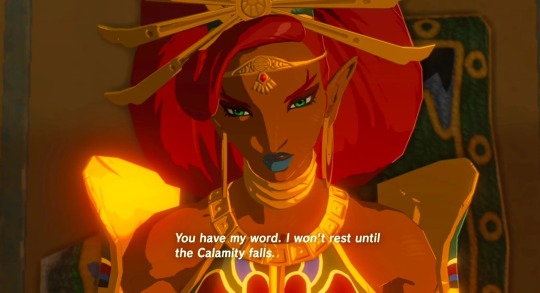
She's not kidding. She literally never gets to rest in peace until the calamity falls.

He certainly takes pleasure in taking revenge, a hundred years later.

Please, Daruk. Please don't say that.


She does leave him. To face her fate indeed.
To summarize, basically I thought more about these lines and how they foreshadow what happens and oh my god Nintendo why-
#botw#botw analysis#my stuff#breath of the wild#champions ballad dlc#botw champions#botw champions ballad#botw mipha#botw urbosa#botw revali#botw daruk#mipha#urbosa#revali#daruk
1K notes
·
View notes
Text
Get Your Tissues ready! We're Analyzing the German Dub of Zelda's Awakening (BotW)
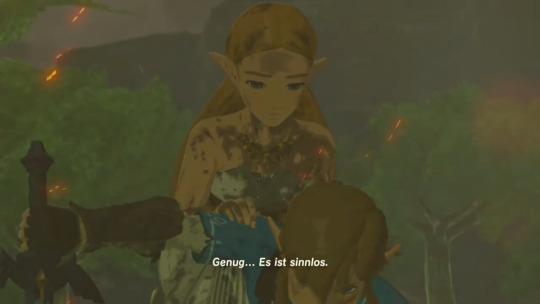
Translation: Enough... It is useless.
English Localization: Link, save yourself! Go!
As a Zelink shipper, I actually really love the English version of this line, where Zelda tells Link to not die for her. However, as a writer, I prefer the German version. See, in the English version of the game, Zelda strikes me as almost blind to the reality of the situation. Meanwhile, in German, she is desperate because the situation is, quite frankly, hopeless - note how she even states that it's useless (to fight) here. I'm going to come back to this later, so keep it in mind. For now, let's move on.

Translation: I beg you... You mustn't die too...
English Localization: I'll be fine! Don't worry about me!
Zelda uses the expression auch noch here, which technically means too. However, it implies something happening on top of everything else, in this case, after everyone else has already died. This also serves as a transition from the previous memory, in which Zelda states (in German) that everyone is dead because of her.
Again, my Zelink heart loves the English version, but I think the German version has its own appeal. Considering that Zelda blames herself for the deaths of the four Champions, and that she doesn't want Link to die too might not sound Zelink-y at first, but consider for a second. The Champions were Zelda's friends, and one of them was her mother figure. Her father is also dead. She pretty much has only Link left at this point - and we can guess from the other memories (as this is the final once you find in the game) that even though they had a rough start, he is extremely important to her. Even though it's not as explicit as in English, I think it's still a really nice moment that shows how important he has become to her, as more than just a bodyguard.

Translation: Run away!
English Localization: Run!
I really like the contrast between the scene in which Link protects Zelda from the Yiga, and this scene. There are some obvious parallels, only that in this scene, Link is too severely injured to save Zelda anymore (and in the end, she saves him instead). He tries his best though. I very much appreciate the effort that was put into his expression in this entire scene!

Translation: No!!!
English Localization: No!
... Three exclaimation marks, guys. Three. Exclaimation. Marks.
Okay, but seriously, I kind of love his moment where Zelda throws herself inbetween Link and the Guardian. It contrasts nicely with how Link protects her from the Yiga earlier in the game's backstory, and also with how he tries to defend her (even though he's gravely injured) in this scene.

Translation: Was... Was that me...?
English Localization: Was... Was that...
I really love that Zelda's Lullaby is sung by a choir after she purifies the Guardians. Also, the fact that she is shot from bottom view here, which makes her look greater, and also reminds me personally of the Goddess Statues a bit. All of this invokes awe, and really conveys that something very powerful and important has just happened.
On the localization note, I like that Zelda specificalls asks if she herself just did that in German. After blaming herself for pretty much everything that went wrong throughout the entire backstory and feeling useless, this is a very important moment for her, and the German localization makes it about her, both as the wielder of the sacred power to seal the darkness, and Zelda as a person.
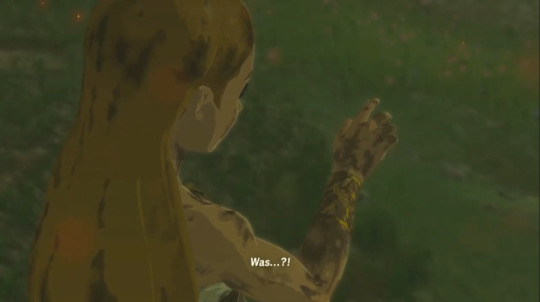
Translation: What...?!
English Localization: The power...
I like that we get a shot of the back of Zelda's hand too, showing that the triforce that appeared earlier has disappeared again.
I like that Zelda is more stunned and confused as to what just happens in the German version. In English, she seems to know what's up right away, but I actually like that she seemingly needs some time to process (which she won't get unfortunately - someone give this girl a break!) what just happened. Really helps reinforce the gravity of this event!
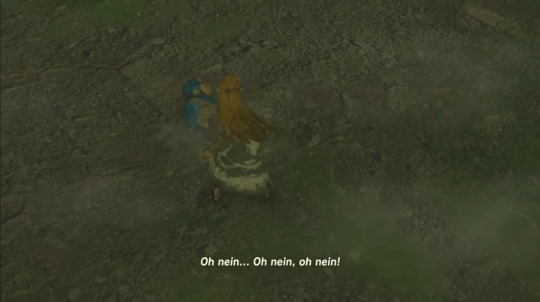
Translation: Oh no... Oh no, oh no!
English Localization: No, no...
Despite the fact that she would need time to process what just happens, Zelda immediately looks after Link when he collapses 🥺 If that doesn't show you how much she cares about him at this point, I don't know what does.
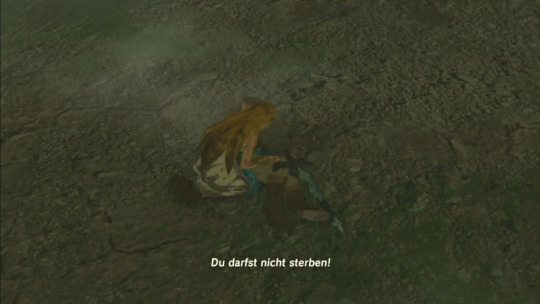
Translation: You can't die!
English Localization: Link! Get up!
Zelda uses the same phrasing (darfst nicht) as before, but this time, it's much much desperate. While before, she was trying to get Link to run, she is scared for his life now. Before, she used the phrase more in a sense of "if you keep going, you're going to die like everyone else, and you must not do that" in an attempt to get Link to run. Here she is using it more like "this can't be happening", desperate and unwilling to accept Link's impending death.
Julia Casper's (Zelda's German VA) voice acting is also phenomenal here. You can hear a little sob when she says this line, and it really conveys her despair.

Translation: Please, don't die...
English localization: You're going to be just fine...
Again, same phrasing as before, only that this time Zelda is explicitly begging Link not to die in the German line. I think it's both impressive and authentic that they used the same line three times, but each time with a different connotation. Zelda is completely exhausted and stressed in this scene, so she wouldn't have time or energy to think about how she expresses everything she wants to, so she just repeats the same core thought over and over: she doesn't want Link to die.
In the English version, she seemingly tries to calm Link instead. While on its own, I do like this line (especially as a Zelink shipper!), I do not like it in the context of this scene.
Remember how I said I was going to come back to Zelda seemingly not understanding the severety of the situation or being in denial about it earlier? Yeah, this is where the scene becomes... Weird to me in English. See, we never see her realize that actually, things do not look well, and no matter if you're going with the not understanding interpretation or the denial one, this causes a break in the narrative for me. Her view on their situation seems to change in-between lines, without an actual indicator of the change. It very much comes off as unnatural to me, especially with what happens next.
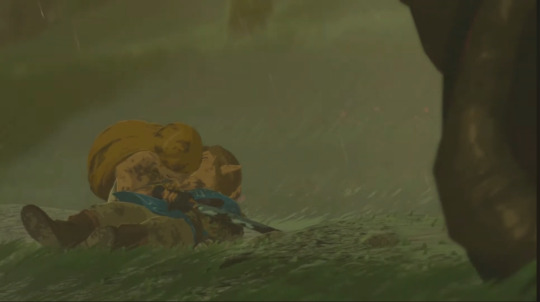
No text here, just sobbing. I wanted to note this because Julia Casper's voice acting in this particular bit of the scene sounds like she is actually crying. You can hear her sob and whimper (the really quiet one she does right after Link falls unconscious always gets me the most), and it's absolutely heartbreaking. It actually had me cry too every time I saw this scene in my playthroughs of Breath of the Wild.

Translation: There... Is still hope?!
English Localization: The sword...
Julia Casper makes this line (and the next one) sound like Zelda is still processing things once more, and I think it is very fitting.
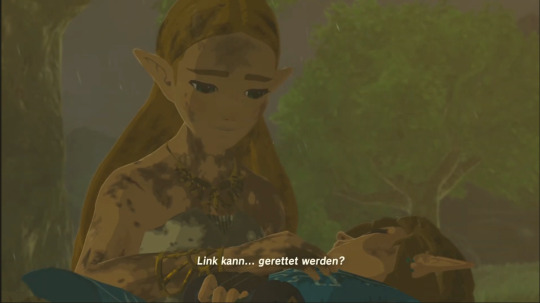
Translation: Link can... Be saved?
English Translation: So he can... He can still be saved?
I do like how this line and the previous one feel completely different in German and in English contentwise.
While the implication in English seems to be - at least in my opinion - that Zelda sees that the sword is still glowing, and comes to the conclusion that Link can still be saved by herself.
Meanwhile, in German the implication seems to be more that the sword tells her that Link can be saved, and she somewhat confirms this in her conversation with the Great Deku Tree later.
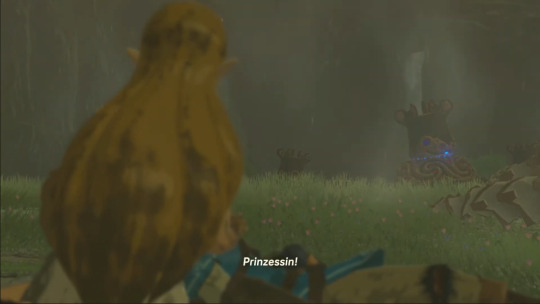
Translation: Princess!
English Localization: Princess!
... I do not like this line. It sounds like they're playing hide and seek, not like they just found the princess who has probably gone missing in all the chaos and who probably a lot of people were worried for. In both German and English (it actually does sound a little bit better in English IMO). Kinda disturbs the scene a bit.
I do like that they actually have Zelda gasp in response to this though.
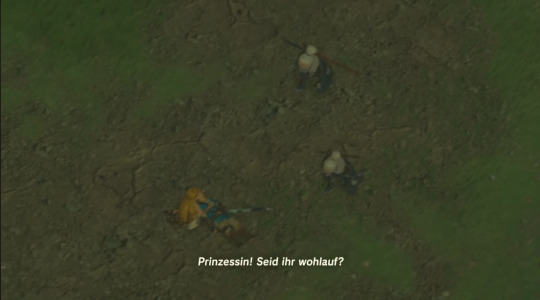
Translation: Princess! Are you alright?
English Localization: Princess! Are you all right?
Yeah, that line is better.
Also, look, Zelda still has her hand on Link's chest 🥺
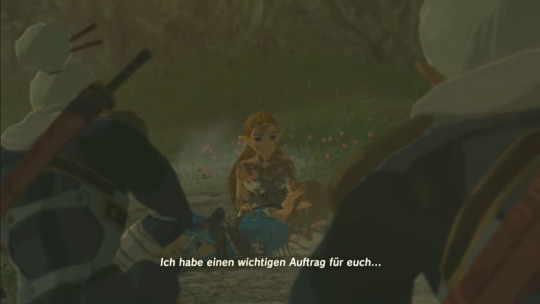
Translation: I have an important mission for you!
English Localization: Take Link to the Shrine of Resurrection!
Zelda sounds suddenly really confident and serious with this line in both languages. My guess is that it's because she knows that if she doesn't act, then Link will die, but also because she has trouble opening up. We learn this from her diary, and we know from both that and from other memories that she feels comfortable to show her true feelings and worries around Link (who is unconscious).

Translation: Take this man to the Shrine of Life as fast as possible!
English Localization: If you don't get him there immediately, we are going to lose him forever!
The Shrine of Ressurrection is called the Shrine of Life in German, possibly because the localizers thought that Schrein der Wiederbelebung or Schrein der Auferstehung sounds too complicated or too much like Link is a zombie now.
Also, Zelda calls Link a man in the German dub at this point, which actually caught me by surprise when I first played the game since Link just looks so young. I guess it's a reminder that they are already around 17 in this game, and that Link is a full-fledged knight. I also think it shows respect for Link on Zelda's part.
I actually prefer the German version of this line, simply because I think it works better in tandem with the shot we're shown. The delivery of the English line is great too though (and I say this as someone who usually doesn't like Zelda's English voiceacting that much).
Also, look how Zelda is supporting Link's head 🥺

Translation: Hurry!
English Localization: Is that clear?
Two different lines here, but I think both work. I also like that we get to see the reaction of the two Sheikah guys.

Translation: Before his light of life...
English Localization: So make haste and go!
Lebenslicht (Light of Life) is a more poetic way to say someone's life in German. It's not the same as light of someone's life.
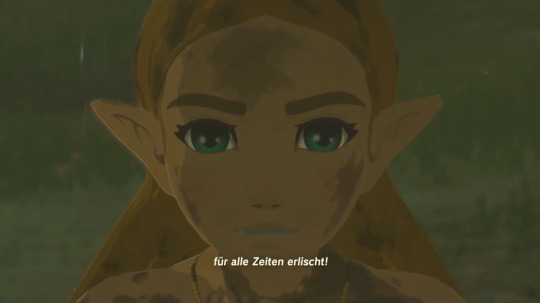
Translation: ... goes out for all times!
English Localization: His life is now in your hands!
Using the plural of the word time like this is actually quite common (even though using the singular wouldn't be incorrect), and I will admit that I have never really thought about why we do this before. I think in this particular case, it might be to emphasize the gravity of the situation, but this might be interesting to look into in general.
That being said, I actually prefer the English line over the German one here. I think it just provides the better ending to an overall very grave, very serious scene, that's pretty much the direct leadup to Link waking up at the beginning of the game.
In general, I think this is definitely one of the most impactful scenes in Breath of the Wild, and both the English and the German version do a great job at conveying this. The camera also works with the localizations (more or less) to improve its impact. Overall, analyzing it was very interesting.
What are your thoughts on this scene? Tell me in the comments, reblogs or tags if you want to 🙂 Thank you for reading!
#Meta#Zelda#Link#Zelink#Analysis#The Legend of Zelda#LoZ#LoZ Meta#LoZ Analysis#Breath of the Wild#BotW#BotW Meta#BotW Analysis#Localization#English#German#BotW Localization#LoZ Localization#Zelda's Awakening#Currantlee here#Currantlee translating#Currantlee analyzing
56 notes
·
View notes
Text
youtube
I stumbled across this video, it's about 10 minutes long if you have the time, but honestly it perfectly illustrates my feelings about botw/totk
I feel quite an isolation from fandom stuff because I haven't been able to love totk the same way I do botw, and this is kind of why.
Totk is a good game, objectively, without doubt. It adds so much. But honestly I don't like that there's so much to do. I'm not a particularly engaged gamer, coming from the likes of animal crossing, so the open air and easy vibe of botw appealed to me. I found myself overwhelmed by the endless tasks, resource collection, and places to revisit in totk that it felt a bit more like get to the end than enjoy the atmosphere as you go.
I feel like the negative space in the game gave the fantastic atmosphere space to breathe, and made the more engaged parts of the game feel more exciting by comparison.
I do feel as though totk could have done a lot more if it hadn't been stuck on structurally following botw. In botw, the vast map, fragmented memories and link's silence fit with an atmosphere of isolation and the aftermath of a great tragedy. (I may also personally be biased cause I'm a depressed bastard and I like those themes...)
But totk has a different story. It's about rebuilding, and community. I don't feel as though the focus on the past worked as well as focusing on the future could have. It felt somewhat repetitive for reasons that didn't benefit that specific story, where they could have done something different.
Anyways, no hate to totk, it's a good game, but I just wanted to share this as I was surprised to come across a video saying exactly what I've been thinking when I couldn't even say it.
#loz#botw#totk#im gonna go play botw again sometime soon i forgot how much i loved it#breath of the wild#tears of the kingdom#zelda#link#botw analysis#totk analysis#botw vs totk#Youtube
12 notes
·
View notes
Text
Magic in BOTW: A Study of Elemental Weapons
Breath of the Wild is kind of vague when it comes to magic compared to other Zelda games. There’s no magic bar or characters that are mentioned to specialize in it, (aside from the dragons and maybe the champions). In fact, the magic that tends to be used the most seems to be from the Yiga. Sure, great fairy's and forest spirits like the koroks and blupees kind of have their own thing but I’m focusing on Hyrulians today.
Rods:
Though mostly used by Wizzrobes, according to their descriptions, the monsters did not create them. Fire/ Meteor Rods are described as being ‘crafted by an ancient magician’, Ice/ Blizzard Rods are ‘crafted from refined ice found at the summit of Hebra Peak’, and Lightning/ Thunderstorm Rods have a ‘gem [that] contains electricity from the Hyrule Hills’.
Hebra Peak is made up of special unclimbable ice that can also be found in the cavern that entombs the hebra great skeleton, this could be the refined ice that the ice rods are powered by. While ‘Hyrule Hills’ aren’t a specific place in the game, maybe that’s what Farosh Hills were called, as they’re also the hills that surround Lake Hylia which has several other similar names. (Lake Hylia, Hylia Island, Bridge of Hylia, Hylia River) Perhaps before Farosh showed up, the eastern hills had a similar name, But Hylia Hills sounded like a dirty joke so it was changed to Hyrule Hills.
Now, what about an ancient magician? One that’s only associated with fire magic... My immediate thoughts would be Twinrova or a magically inclined Goron (which is more likely but we’ll get to that a little later), in any case, their name has been long forgotten but who’s to say we haven’t met them before?
Also there’s definitely an aspect with using elemental powered gemstones for both the rods and the weapons. Each of their designs feature it at the end of their hilts and it just makes sense for the gemstones to either assist in the generation of elemental magic or the regulation thereof.
Flame Weapons:
Descriptions of the flame weapons describe that they were made in the fires/ lava/ magma of death mountain. This makes sense, this is not a new concept, I mean its the whole plot to the lord of the rings. but what really is interesting is when we get to the description of the great flameblade.

‘by Goron smiths in an ancient age’. Now that’s Lore! So there’s magic gorons. I’m thinking this is in the ten thousand years before botw/ golden age of Hyrule unless we can attribute this to existing characters. Maybe Darunia was really into making fire weapons or something. He was the Sage of Fire, that had to count for something.
Ice Weapons:
Like the Ice Rods, they were made with the ancient ice from the hebra mountains, though in the great flameblade version it ‘was forged by smelting ore found in the Hebra Mountains’ permafrost’ so that’s a thing. Hebra is mostly inhabited by Rito, who aren’t known to be very magically inclined, but there are also some Hylians. The area is generally pretty desolite with not a lot of evidence of civilization so it’s hard to tell who could’ve been behind the magic in that area. There’s the Zonai labyrinth and the entrance to the ice cavern looked vaguely Zonai or ancient Hylian in origin (like the ruins around the springs and the forgotten temple and Lanayru Promenade, like sksw era ruins)
Anyway the Ice is magic, but only the Hebra ice, not like the ice around the goddess spring or the ice around the actual ice dragon, no that ice isn’t magic. The random ass ice in hebra is the special magic ice. No, I don’t get it either.
Lightning Weapons:
Now here’s where it gets interesting. You’d expect that the magic from the electric weapons would come from the Faron region. WRONG. But that doesn’t matter. We’ll get to that.
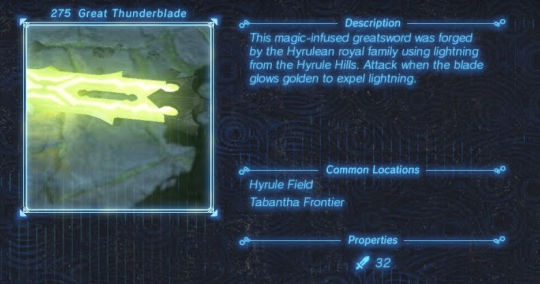
The Hyrulean Royal family is who is behind the thunder weapons. Which is odd, the royal family isn’t generally associated with weapons or lightning. or are they? One character comes to mind when I think of both Hylian royal family and lightning (and also making weapons), and that is Skyward Sword Link. So maybe the royal family could be linked to that but it still seems weird that they are the origin of them. Perhaps they had help from the sheikah, they had to do a whole lot of stuff with electricity just for Vah Naboris. Those metal orbs do remind me of the lightning enchanted metal...

This ball. the color is the same (but less bright) but still. Same vibes.
Lets get back to the Hyrule Hills thing. The thunderspear description clears this one up a little.
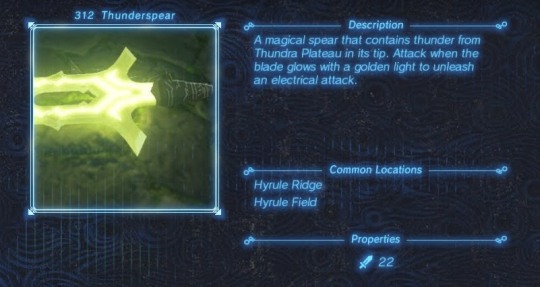
The lighting comes from Thundra Plateau, aka the place with the glowing balls and the eternal storm that I guess was going on for like ten thousand years, waiting for the shrine to be solved by the hero. This place is also heavily associated with the Zonai, as the ruins are the same as the ones around the spring of courage and in the dark shroud of Thyphlo.
Arrows:
The elemental arrowheads look different than the normal elemental metals. The only context that we get for them is that they are ‘imbued with the power of [insert element here]’ and while it would make sense that the arrowheads are just the same magical metals but cut up to be smaller but I would argue against it. There is probably a finite amount of elemental arrows and weapons that can have their metal harvested to make these arrows. Most vendors of these arrows claim to ‘find’ them rather than make them, and they also only tend to sell certain types rather than the entire roster. The arrow lady in Kakariko only sells fire arrows on top of their normal basic arrows, Rito Village and Hateno sell bomb arrows, etc. Only Tarrey Town and Gerudo Town sell packs of every type of arrows.
Anyway I’m absolutely convinced that the arrow lady in Gerudo Town is the creator of the elemental arrows. Gerudo Town is not new to enchantments, especially ones featuring gemstones, they’re also more associated with sorcery than the Rito kid who is the vendor in Tarrey Town.
I could talk more about magic in botw (the champions powers, the magic found in nature with gemstones and plants and animals, the sheikah and yiga abilities, magic in clothing, and also minor deities featured in botw, I will talk about these things if there is any demand or if I feel the inspiration to.) So this could be a series. So please tell me if you’d be interested in that because I would love to make more random in-depth analysis’.
#long post#i am not going to add a read more#botw#botw lore#breath of the wild#loz breath of the wild#legend of zelda#zelda lore#botw headcanons#botw analysis#video game analysis#I literally could not function until I finished this and now that it's over I have no idea what to do with myself
115 notes
·
View notes
Text
On Awakenings in The Legend of Zelda, Part 4: Why Can't Fi Just Talk in BotW?

On Awakenings in The Legend of Zelda Part 3 established evidence that Fi can no longer talk to people at all on her own - and people have to meet specific requirements in order to talk to her: they must have their own magic and they must be fully aligned with the Triforce of Courage. Up next:
Why Can't Fi Just Talk?
1.) The first clue comes from Skyward Sword's ending.
At the end of Skyward Sword, Fi tells Link he must return the Master Sword to its pedestal. Here's some important dialogue from Fi:
- "Master Link, you have successfully protected the Goddess reborn and defeated Demise, fulfilling your role... My purpose here is complete."
- "Drive the sword into the pedestal before you, and I will return to the sword to enter a sleep without end."
- "...at the end of my journey with you, as I prepare to sleep within the Master Sword forever..."
She hopes they'll meet again in another life, but says her sleep is without end. Hmm.
Here's my interpretation: Hylia created Fi specifically for this mission. Once it's over, she powers down. Whatever energy she had that allowed her to manifest physically and be heard by others will be gone. It's not clear to me precisely what this energy is, but it is clear Fi knows she won't come back out. She'll 'sleep' forever.
The punchline: Fi changed permanently at the end of Skyward Sword--she is 'asleep.'

2.) Link must expend his own life force to pull the sword from its pedestal in BotW.
The Deku Tree warns Link that if he tries to pull the Master Sword in any kind of weakened state, he will lose his life where he stands.
Wow.
...Why?!
Link needs 13 hearts or more to pull the sword from the pedestal. Link's life energy drains as he pulls it out.
I highly doubt either Hylia or Fi think it's fun or necessary to play chicken with the life of the chosen hero. It's much more likely they have no choice.
If Hylia meant for the Master Sword only to be used for one mission and then powered down, what's left to power it? What can allow it to perform its magical wonders? What can provide the magical energy to allow Fi to be heard?
The answer seems simple: Link can. Link is magical.
In BotW, he gains 'spirit orbs' from monks, spiritual energy Hylia can convert into life force or stamina. I think you can interpret the expenditure of this energy as being required to activate the sword.
The punchline: It takes energy to activate the Master Sword in BotW.
3.) The Master Sword requires magical artifacts to be pulled in other games.
Is there any other evidence for the energy punchline above? Yes!
In Ocarina of Time, A Link to the Past, and A Link Between Worlds, Link can't pull the Master Sword unless he has three other objects. In OoT, they're the spiritual stones. In ALTTP, they're the pendants of power, wisdom, and courage. In ALBW, they're the pendants of virtue.
Granted, this is a story device to get you to take Link to the three overworld dungeons in each game. However, Nintendo put them there, so they're canon--and they're presented as powerful magical artifacts. In the case of OoT, they're meant to be part of the seal to the Door of Time. In the other two games, they're not! They're just... required to pull the sword. Without them, Link can't do it.
So, what's their purpose?
In context with BotW, it's easy to argue their magical energy is expended instead of Link's life. In both cases, without extra magical energy from somewhere, Link's going to be under 13 hearts and he'll either die or fail to pull the sword.
This doesn't happen in Twilight Princess, but it's the only game in which Link already has the Triforce of Courage when he pulls the sword! I can easily believe the Triforce of Courage provides the needed energy. (This is a whole other post, too, for later).
The punchline: After Skyward Sword, Link always needs something magical to pull the master sword, even if the magic comes from Link himself.
What about the Oracle games or Zelda 1? The Oracles' 'master sword' is not the true sword--it's the noble sword with a power upgrade. In Zelda 1... if you take the 'white sword' to be the Master Sword (with its name forgotten), the sword is lying in a grave. Three guesses whose. It doesn't have to be pulled. The situation is different.
4.) Link is canonically magical, with or without the Master Sword.
Link can perform his clearly-magical spin attack (it fires energy outside the reach of the sword) no matter what sword he's wielding. That magic must be coming from Link himself--not his sword.
Link's cool bullet-time/flurry-rush abilities in BotW are intrinsically his. He doesn't need any magical objects or power-ups in order to use them.
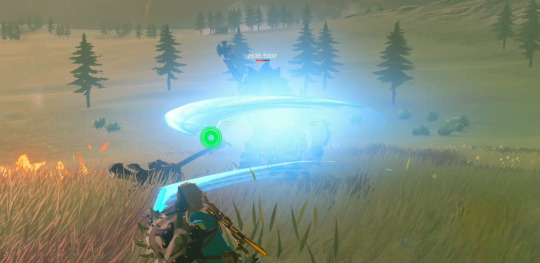
Link fires a long-range sword beam from the Master Sword at a Lynel.
The screenshot shows a subtle example of Link's own magic. The Master Sword can only fire its signature long-range energy beam if Link is at full hearts. There's no reason for this to matter unless the magic's coming from Link himself. (It's like the sword won't automatically take energy from him if he's not 100%).
When Zelda gives Link the Bow of Light in BotW, its description says, "When wielded by the hero, it fires arrows of pure light strong enough to oppose the Calamity." It doesn't do that if just anyone picks it up! Just the hero. I think this connects to Zelda's dialogue at the very start of the game: "Link... you are the light" - I think she's speaking more than figuratively here. I think Link's actually hurtling his own magic when he fires this thing.

Link fires a light arrow at Dark Beast Ganon.
Another tidbit: SS Zelda tells us Link has an "unbreakable spirit" and she needed someone with one--so presumably, this means something extremely special about Link's actual soul.
There are probably more, but this is already long enough!
The punchline: A lot of the magic isn't in Link's sword. It's in Link.
Not that the Master Sword isn't magical at all, but Link's the powerhouse. I like to think of the Master Sword as the ideal conduit for Link. In the series, it's sometimes described as a key to a lock.
5.) The Master Sword ceases to function entirely in the Wind Waker timeline.
WARNING: Spoilers for the ending of Ocarina of Time.
At the end of Ocarina of Time, Zelda sends Link back 7 years so he can have the rest of his childhood, causing an unexpected and extremely serious problem when our kind ten-year-old Link uses the opportunity to change the past so OoT doesn't happen at all.
Unfortunately, this is a paradox. If OoT doesn't happen, there's no reason for Link to change it, therefore he can't have gone back... etc. There's no resolution to this except a timeline split.
So, OoT Link returns to the past, but creates a new future. This has orphaned the adult timeline's future without the soul of the legendary hero. That's why the hero 'does not appear' in the backstory of Wind Waker (because it's on that orphaned adult timeline).
And... what has happened to the Master Sword in this timeline?
It has died.
Its blade has gone dull. Its hilt has turned in on itself like a dead insect's legs. Its length has shortened drastically, closer to the length of the original Goddess Sword. It has lost its 'power to repel evil'--and the only way to put any power back in it is for the sages to pray, putting magic from elsewhere into it.
(Wind Waker 'Link' is not actually Link - he's a very brave kid who, as the King of Red Lions says, bears 'no relation to the one who came before.' So, WW Link can't power up the blade.)
The punchline: The Master Sword does not function if Link's soul is removed from the timeline. It's dependent on him.
There's another piece of evidence directly supporting the sword's dependence on Link! Here it is:

Link forces himself to his feet to defend Zelda to the last on Blatchery Plain.
Look at the condition of the Master Sword. It's physically ruined, full of deep gashes, its trademark bright gleam is gone, and it has lost its edge. This has never happened in any other Zelda game.
But Link also never believed he was about to lose, either. Link believes, in this moment, he is about to die and he will also have failed. He has lost hope. All he has left is the one last sacrifice he can make, to step between Zelda and the guardian.
The sword looks like this not because Link has used it too much, but because of Link's mental and physical state. Once Link lost everything he could possibly give to the sword, it became ordinary and gave in to material wear just as any other blade would.
Gathering the punchlines from this section:
vi.) Fi changed permanently at the end of Skyward Sword--she is 'asleep.'
vii.) It takes energy to activate the Master Sword in BotW.
viii.) After Skyward Sword, Link always needs something magical to pull the master sword, even if the magic comes from Link himself.
ix.) A lot of the magic isn't in Link's sword. It's in Link.
x.) The Master Sword does not function if Link's soul is removed from the timeline. It's dependent on him.
All of those punchlines together lead to this conclusion:
Fi can't just talk whenever she wants because she doesn't have the power to do so after Skyward Sword. The effort (magical energy) must come from the person who's speaking with her.
The person Fi speaks with must be magical.
I propose to you that Link himself is now the only source of power for the Master Sword if he is wielding it (unless he intentionally powers it up in other ways), and this includes speaking to Fi.
I also propose Zelda's magic can power Fi in the same manner.
I think neither of them could speak with Fi until they met that one last requirement from the previous post, On Awakenings Part 3:
Link having magical power is not enough to allow him to hear Fi--he must also meet at least one other requirement.
(In BotW, he meets that requirement on Blatchery Plain when he steps between Zelda and that final guardian.).
That brings me back to the assumption I made in On Awakenings 2, that Link must be fully aligned with the Triforce of Courage as that one last requirement. (The reasoning for why that specifically is in posts 1 and 2).
And that, in turn, clarifies why none of the other magical people could hear Fi in BotW: because none of them had met that one last requirement.
-----
[I'm going to end up doing more... because I still haven't answered the specific questions about my fanfic yet 😂]
[A cool way to interpret the idea of her 'sleeping forever' combined with the idea of her hoping to 'meet Link in another life' could be that Fi is actually going to the Spirit Realm... and that's why she's asleep...]
[...I'd better make a post list for these.]
#loz#botw#zelda#breath of the wild#legend of zelda#fan theory#zelda theory#zelda fan theory#loz theory#analysis#botw analysis#skyward sword#oot#alttp#fi#master sword#the master sword#longpost#i hope I didn't forget anything
74 notes
·
View notes
Text
I do love that one of the messages in Breath of the Wild is about the duality of technology.
Like YES, technology can make your life so much easier, can provide protections and aids that can make you sleep easier at night, BUT
misuse of technology or corruption of it can cause more harm than good. Especially when someone uses your own technology against you, it can put you and your loved ones in a lot of danger.
Balance and caution is the best option.
#i could go on about this and write y'all a whole essay BUT#alas i am hungry at the moment#botw#botw analysis#well a mini one anyways
7 notes
·
View notes
Text
a lot of people have already pointed out how totk has a lot of themes of imperialism and generally leans conservative ideologically, but what i think is interesting is how totk subtly redefines what a “researcher” is.
zelda wants to be a researcher in botw, and what this means in the context of botw is largely someone who works with sheikah technology. she wants to figure out ancient sheikah tech, she has an interest in botany and otherwise nature and biology (the whole silent princess and the frog thing), robbie and purah, the two characters who are the closest to us seeing what a researcher in the context of botw is are basically inventors. in totk, however, the main researchers who are presented to us are all historians.
this is an interesting pivot, because in botw zelda is not really interested in history. if anything, the one who’s deeply concerned with history is rhoam, wanting to preserve historical tradition and his uncritical reliance on said tradition and historical precedent is what leads them to their doom. in botw, zelda is narratively opposed to history, if anything, all the ancient tech backfires on them and traditions fail to awaken zelda’s power. zelda’s urge to be a researcher is in wanting to understand the world around her, not just blindly follow ancient plans but rather have agency within them.
totk, however, is obsessed with ancient plans. the only real moment where zelda gets to geek out in totk is her getting all giddy about finding out more about the divine origins of hyrule. all the researchers in the game are concerned with finding out more about the zonai. since all the mentions of ancient sheikah technology are scrubbed from the game purah and robbie read more as strange outliers, the sheikah slate is no longer, now it’s the purah pad, a product of purah rather than something larger. the whole game is literally about following an ancient plan, a plan most characters don’t fully understand as they sign up for it. totk’s main story is built on confusion, on the characters not knowing what’s fully going on but having faith in ancient sages telling them what to do. in botw, following ancient plans you don’t fully understand was the thing that doomed you. in totk, following ancient plans you don’t fully understand is the gimmick.
that juxtaposition between the two games has an ideological through line: botw posits that progress is necessary. mindlessly relying on tradition doesn’t work. prophecies are omens, not instructions. history must be learnt from, not repeated. the ancient sheikah aren’t a group to be emulated, but rather to be learnt from, considering their machinery backfired and the royal family betrayed them. totk, however, is obsessed with the mythical history of hyrule, a time where everything was idyllic until one bad man showed up, a time we must emulate in order to win. i already talked about how the past in totk is zelda’s life pre calamity but better here, but that also plays into the idolisation of that era and its royalty. in botw, even the myth of the first calamity preserves the fact that the yiga clan has origins in the royal’s family persecution of the sheikah, even the time when they successfully held back the calamity is tinged with mistakes that still affect the world ten thousand years later. in totk, ganondorf’s origins are nebulous. nobody provoked him, nobody did anything wrong, he’s just evil because he is.
a lot of right wing ideologies are hinged on preservation, but more than that: the belief in the nebulous mythical past in which everything was better. “make america great again”, the fascist’s idolisation of ancient rome which is represented largely inaccurately, look at any conservative rhetoric and you’ll see people complaining about how things nowadays are ruined or are being ruined, how in the past things were this way and they’re not anymore, which is bad. the belief in the fact that in some past period we were great and are not anymore, and the strive to emulate that past is a trait highly typical of right wing ideologies. and in totk the past as a great era is an idea presented completely uncritically, the narrative is entirely controlled by the game and doesn’t dwell on any of the inconsistencies in this idea.
now, obviously, not every story in which a great ancient era exists is fascist, right wing or conservative. but to me what’s interesting specifically in totk is this shift between the two games: botw is critical of the past. it’s critical of arrogantly repeating history, it’s critical of having blind faith in great relics of the past. totk isn’t. totk idolizes the past, totk tells legends and tells you to believe them without any doubts. botw believes researchers are those who seek to understand the world, innovate it and solve problems without relying on ancient ways. totk believes researchers are those who discover ancient instructions, ancient ways and relay them to great men in the present to be followed. the four mainline regional quests in botw are about discovering four ancient relics that are terrorising the land and fixing the mistakes of the past. the four mainline regional quests in totk are about discovering four ancient legends are true, and receiving instructions from an ancient sage on what to do.
totk is not simply neutral, it is ideologically conservative in stark contrast to botw, because of the things it chooses to leave uncriticised, notably the things botw was very poignant about examining critically. the way totk redefines what is a researcher is indicative of this, indicative of the way it chooses to idolize or present as an unexamined good that which was nuanced in botw. totk isn’t just conservative in the sense that it presents uncritically a “good king” and “evil conquerer”, it goes deeper, it’s notable because botw was starkly opposed to the thematic axioms totk presents.
i just think it’s very interesting that they made a sequel to botw, and completely redefined or otherwise ignored botw’s thematic core.
#totk critical#loz#botw#totk#legend of zelda#tears of the kingdom#breath of the wild#meta#analysis#my hot takes
2K notes
·
View notes
Text
I was watching a video analysing how the Yiga clan were handled in botw and how the person analysing it lamented the fact that Kohga was a joke character who totally destroyed the much more threatening image the yiga clan had all throughout the game. Although I do understand the sentiment (I felt that way for a long time) I’ve come to realise that we might not be viewing it in the right perspective. I ended up writing a comment under that video explaining how I saw things, and realised that maybe it could interest people here too? So here is the fleshed out version of it:
I think part of why they made Kohga extremely goofy compared to a way less goofy clan of literal assassins is to emphasise how even though the clan originally held some understandable beliefs, it has become a cult of personality over the years, and like most cults, the leader is way less charismatic than his followers make him out to be. Indeed, from the outside, it seems absurd how anyone could take Kohga seriously, let alone kill under his command, but from the inside, Kohga is the Beloved Leader That Guides Them Towards Victory, and anyone threatening him deserves to die.
In a way, yiga clan members feel like vulnerable, impressionable people who were enrolled into a cult and given a Big Family and a purpose (and a lethal weapon) by their lovable Master Kohga who wants the best for them… Except if you want to get out, then you’re a filthy traitor who also deserves to die. It’s especially visible when you beat him and they all get personally mad at you for killing him. They didn’t care about Ganon, they didn’t seem to actually understand the bigger picture, they only cared about Kohga.
It also shows how, like the rest of Hyrule, the Yigas are very much disconnected from their own history, seemingly holding on the grudge their ancestors held more as an excuse to continue to enact violence and perpetuate the cult of personality than fighting for a “noble” cause. Only Kohga seems to actually care about Calamity Ganon, and the rest of the yigas seem to be just tools to him. Wether or not he’s actually conscious of what he’s doing is unclear. Is he a fully aware con artist, or is he purely another product of Yiga indoctrination?
So yeah, to me it feels like a parody/critic/mockery of cult dynamics. It shows that this gang of assassins are indeed a real menace, but for seemingly no reason other than “that one lunatic they admire told them to” and “if they go away they get killed”. The reason why the clan was originally created becomes almost anecdotal. Under the current leader, no one is required to actually know what they’re doing, they just need to follow orders.
In the end, I think it is the intention the developers had because cults are a rampant problem in Japan. At the very least, even if it’s not a actually conscious critic, it’s a concept that is much more present in their cultural landscape than ours and that almost certainly influenced how they handled the Yiga clan. Basically, cults are not cool and can even be dangerous both for the public and their members. Cult leaders especially are not cool and often are con artists. Therefore, Kohga couldn’t be badass, he had to be a doofus getting beaten in the most unexceptional way possible.
#botw#breath of the wild#master kohga#yiga clan#kohga#loz#the legend of Zelda#tloz#meta analysis#i purposefully didn’t talk about kohga’s change of heart in AoC because to me this game is not canon#one could argue it proves that Kohga is actually not aware of how catastrophic enabling Ganon would be#but for the sake of keeping it focused on botw I didn’t mention it#cult mention#valictini talks
2K notes
·
View notes
Text
> Becomes a Champion
> Is the only one without magic or a special glowy sword
> Just a guy that flies good and shoots bomb arrows
> First interaction with the main character is challenging him to a duel in a place he cannot reach
> Dies
> Calls the guy who defeated his killer lucky
> Girlies on tumblr decide to ship them, is one of the most popular ships in the fandom
> Becomes simultaneously one of the most loved and most hated characters in the Zelda franchise
> Still has a group of loyal fans despite the last game he was even in being released over 3 years ago
> Refuses to elaborate
> Leaves

#king shit#this is so stupid lol#this is mostly a call out to myself because I read exactly one analysis post for why Revalink works then became obsessed with them for years#botw#revali#revalink#kinda?#link
375 notes
·
View notes
Text
I like the subtle way TotK shows that Link has regained his memories, grown older and more mature. While he is still a goof sometimes, he jokes much less overall (it also better fits the tone of the story that he's less often in a joking mood). TotK Link always handles the Master Sword seriously, while BotW Link does so for a whole of five minutes before proceeding to essentially show off. It's subtle things like that that show how one is a teenage boy (and one with memory loss) and the other a young man who very much knows who he is.
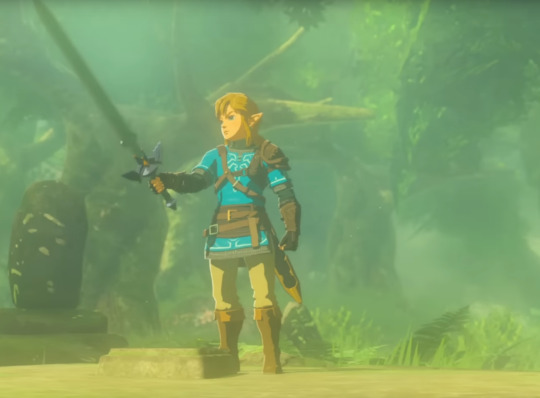
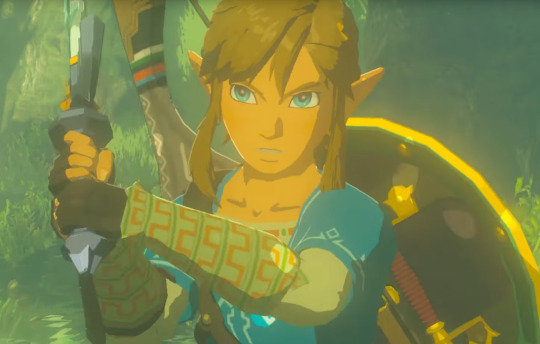
#tears of the kingdom#breath of the wild#botw#totk#loz#tloz#legend of zelda#link#link analysis#botw link#totk link
348 notes
·
View notes
Text
So I noticed something while looking through the "Creating a Champion" art book. (Not sure if this has been touched upon before sorry).

Spoiler: they were planning to have a side quest where you meet Cottla and Koko's mom, who was killed by the yiga clan in Kakariko village. Because of this, they were going to show her spirit.
What interested me, however, was the number of spirit flames she had around her. I know it's not exactly canon, since it was cut from the game, but I find it interesting how she only has 2. I'm guessing this has to do with her being an ordinary Sheikah.
But compare this to the champions and to the king: MORE SPOILERS FOR FINAL FIGHT
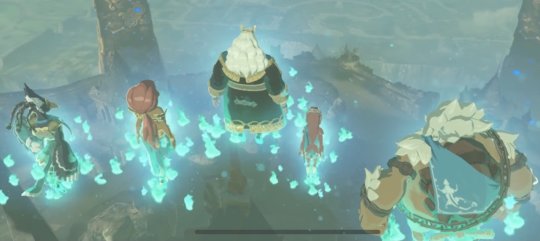
I'm guessing that the spirit flames indicate the level of spiritual power a spirit has, which is pretty cool!
The champions each have special ability linked to their spirits, even after death. Note how Daruk directly mentions that his protection is "from the depths of his soul"

I'm guessing that the spiritual power that the champions had played into how they were able to pilot the divine beasts. So their spirit flames indicate this power. It's a cool detail!
Edit: it's kind of ridiculous how many spirit flames the champions have if we're actually comparing the two lmao.
They're basically walking bonfires at this point.
#botw analysis#botw theory#breath of the wild#my stuff#botw champions#botw king rhoam#botw urbosa#botw revali#botw mipha#botw daruk#urbosa#revali#mipha#daruk#king rhoam#creating a champion#sheikah#botw sheikah
340 notes
·
View notes
Text
back at it again but this time i’m worked up thinking about zelink and sleeping as a way to deal with all of the trauma of immediate post calamity.
because, realistically, they are both going to be beyond exhausted. that fight took everything they had within them and more—link had been preparing for it for months on end without so much as a proper night’s rest, and zelda had been slaving away for the better part of a century using every ounce of energy within her to keep this beast at bay. so it’s pretty reasonable that the first thing the pair of them are going to yearn for is a bed and some damn good sleep now that blood moons won’t be knocking on the window every few days.
but just hear me out. for the first couple of days going on weeks link’s only priority is making sure zelda is okay. he cooks for her, makes sure she’s drunk enough water, and keeps the bedsheets clean and comfortable for her to collapse into them whenever she wants. she’s essentially bedbound for the first week, only ever able to really sit up to eat for a bit before the waves of exhaustion call for her to come crashing back down against her pillow—whether or not she wants to. she’s in no fit state to do anything, bless her, and he recognises that. he’s exhausted beyond reason himself but someone has to be the one sat beside her bed, ready to soothe the night terrors that inevitably creep their way into her unsuspecting mind. he doesn’t really care either. the woman who has haunted everything he’s come across in this world, whose presence has touched almost every memory he can conjure up, whose spirit he just can’t seem to shake because he knows there’s something there, a reason as to why he can’t help but heed her call no matter what he does, has just returned to him. the only surviving remnant of his past, the only face he so desperately wanted to see smile again for reasons he couldn’t dig up—of course nursing her back to health is his first priority.
but she worries about him too, about her knight turned friend who just won’t stop doing things for her despite the fact that she can see the very consequences of his fatigue etched deep into his skin. she wants so desperately for him to stop for a moment and sit with her and let her do something in amongst it all. he’s so much lighter than he used to be before he died but by hylia herself has he not shed the skin of a warrior. he laughs more, talks with a little less restraint, and pulls out all sorts of ridiculous things he’s accrued across his travels for her to marvel at while sat up in bed—all for shadows to have set so deeply under his eyes and his face to have lost a little bit of that roundness she’d grown so fond of. she can see how much he needs to sleep too, to rejuvenate again even though he would simply argue that all he’s done is sleep. she sees it when she peers over the loft banister and finds him, face against arms, asleep at the kitchen table, or when she wakes up and realises he’s fallen asleep sat on the floor with his head against the mattress again and all she can do is feel guilt that she has his bed and not him.
so one day she has enough. she waits until she’s settled into bed with him on a stool at her side, book in hand, otherwise he’ll fall asleep himself, and she plucks it unceremoniously from his hands and discards it on the bedside table. she waits until he looks at her thoroughly bewildered for her to finally muster up the courage to say, “i need you to sleep, link. i see how exhausted you are, i see how much you push yourself. i feel awful for being the only one in this bed, so please, do me a favour, and sleep beside me,” and stares at him with enough conviction to move mountains that her own eventually concedes and climbs in next to her.
it’s nothing more than two bodies sleeping next to one another for the first few days, but it’s enough that it makes a visible impact on the pair of them. zelda sleeps better, more soundly, with a considerable dip in the number of night terrors, while link himself finally just sleeps for the first time in what feels like years. it does them wonders. so much so, in fact, they sleep away the first two days entirely. link wakes up, groggy, and turns over with the intention of getting out of bed because goddess knows what time it is and she probably needs something to eat—but a sleep-ridden hand moves quick enough to land on his shoulder with something mumbled about ‘don’t leave’ and it’s so sincere and desperate that he gives in and turns back over, only for said hand to only still once it nestles itself against the palm of his hand. he’s too drowsy to even think much of it so he just curls his hand around hers in return until that signature hum of hers rings out to signify that her wants have been quelled.
it continues like that, small increases in physical affection, until it’s the norm to absolutely entangle themselves in one another. until zelda is able to do more around the house but potters down the loft stairs in search of him to tug gently at his arm and tell him that she’s tired—a silent ask to come to bed with her even if it’s the middle of the day—and he obliges every time. it’s nice, being this useless to the world, enough where they can gather as much of themselves as they need to by merely sleeping the days away. until their mornings are signified by the raise of the moon and the slow bleed of pinks and oranges into the sky signalling their retreat to bed.
every nap goes the same, too. zelda scoots herself into the inner side of the bed and lays with arms outstretched, waiting for her knight to come clambering in between them so she may wrap them tightly around his warm body and pull him close until his face is nestled deeply into her chest, protecting him the way she’s always wanted to. she may not be able to wield a sword, but she can protect his open heart for as long as her hand weaves through his locks until she feels his body go slack against her. she likes her corner, he likes the safety of her arms, it works perfectly.
impa doesn’t appreciate just how long it’s taken them to realise they’ve been sleeping away the days for over a month now, and thus are visiting late, but it’s hard to object when her princess is sparkling and link looks more like himself than he ever has.
#zelink analysis#long post my bad#hello im back again with the sickness#this time its trauma coping flavoured#zelda x link#legend of zelda#tears of the kingdom#loz link#link#loz zelda#zelda and link#princess zelda#zelink#zelda tears of the kingdom#botw totk#breath of the wild
232 notes
·
View notes
Text
A ramble about Breath of the Wild's difficulty level;

I've poured more hours into Breath of the Wild than I probably should have, perhaps only outdone by my last obsession with Animal Crossing New Leaf. I’ve finished the game twice, and decided I wanted another go. Let me say; it’s rare to come across a game so captivating it makes you want to pour in another 150 hours to see every detail all over again.
My first time playing the game, I was pretty bad at it by any gamer’s standards. If I wanted to go somewhere, I’d quite literally go as the crow flies. I’d cross cliffs, attempt to jump huge rivers, swim across lakes; because, apparently, I’d never heard of roads. At every enemy, I chose flight over fight. I forgot to prepare food before every venture from a stable. There was no strategy, no direction, no intent. I once tried to befriend wizzrobes because I thought they were fairies, and I’ll die disappointed about it.
But I think that was why it was fun. I played the game like a 6 year-old who just wanted to ride horses and find out what happened to Zelda. And the game let me. Unlike most games, where you can only access certain parts of the map at certain levels, I could go the most illogical way possible and this game would just laugh and wish me good luck. I didn’t get stuck, like ever, because I wasn’t bogged down figuring out how it was supposed to be played, how someone else was expecting me to get unstuck.
My second time, I knew the tricks. I knew there were roads and bridges, I knew how to fight from the offset, I knew which enemies were too dangerous to take at the beginning, and how to find everything. This time, I went to Gerudo town first so I could get the magic jewellery, because I knew it would be helpful on the way to getting the proper armour. I played the game the way it was perhaps not so much intended to be – for Breath of the Wild there is, of course, no intended way – but expected to be. Eventually though, I got bored. I didn’t have the patience to drag my heels through the completion of every shrine and puzzle. I just fought Ganon so I could finish the game and start over. Another nice option, might I add.
But why? Well, there was no challenge anymore. I knew how to beat every enemy, what was where. I knew to visit the castle dungeon mid-game to get the goods rather than right at the end where they were little use. I knew every twist and turn, every memory scene, most of the secrets in the map. But it just felt like I was walking in my old footsteps with less wonder and less to discover.
I love Breath of the Wild. I wanted to traverse its wonderful universe a hundred times. But I couldn't just do the same thing a third time, what was the point? I needed something new. A challenge. So on my third playthrough, I had some new rules:
No upgrading hearts or stamina. I could collect every spirit orb in the game, but it wasn’t allowed.
No upgrading runes.
No using the champion gifts, even if I had earned them fair and square.
No fancy clothes. Basic Hylian clothes only. And the warm doublet, ‘cause I said so.
No upgrading clothes either. Not that I’d miss the fairies.
Now, this put me in an interesting position. I played through the Great Plateau as normal, and enjoyed it as I always did. There’s something about it, it’s just my favourite part. Perhaps it’s the secluded area, perhaps the small space as you build from zero. Or maybe the stronger link to the story at that point in the game. I’ve never been sure. But the moment I set foot on Hyrule kingdom soil, there was no more normal; and in a good way.
At this point, I hadn’t considered any other changes to my playthrough, so I set off down the beaten track towards Kakariko village…for maybe 2-3 minutes?. I saw the Bridge of Hylia, and I turned right. Impa could wait.
And it was a great decision. The Faron region is the only one you’re not really directed to in your main quest, when you think about it. Most regions are home to an important village, a major path, or an area where at least part of the main quest takes place. Excluding Akkala, but there’s plenty of direction towards it. So what directs people to Faron? There’s only one memory there, and it’s right on the outskirts. Either you’re aiming for completion, or you’re just plain curious. The latter is the beauty of the game.
The only area that really has a difficulty level intended for a specific point in the game is the Duelling peaks, and to an extent Hateno, suited to be easier in the beginning. So Faron was a fun choice for a first region. Storms, the lightning god, a jungle, a peaceful village unaffected by your main quest? Perfect.
I had my knowledge of how to fight, and of different enemies and whatnot, but I was still in for a shock. Oh yeah. Where most of us would brush a couple of Stalmoblins off, they were a one hit killer for me, and I quickly learned I couldn’t take three at once without getting hit. A rude awakening. So travelling at night was out. I also quickly found I had to restock food at every cookpot, because there was no point in carrying a ten heart meal. Just lots of burnt fish and mushrooms. Classy.
But the biggest change (and my favourite) was the combat. I’m aware that you can buy master mode if you want to make the game more challenging, but what does it change? You take more damage, enemies are stronger, your weapons break more often. To me, that honestly sounds very frustrating. It makes the technical combat more difficult, but it doesn’t change how you approach it. That, for me anyway, was the fun bit.
I remember early in my first playthrough, I was sent to raid a beach camp near Hateno village to rescue some sheep. At this point, I was still a terrible fighter (and a bit of a wimp), so I picked the monsters off one by one with remote bombs until there were few enough to take in one go. It took a while, sure, but hell was it a satisfying victory. Now, two playthroughs later, it was back to that kind of strategy. Analyse your surroundings for things to drop or to blow up, approach from the right place, bait monsters out to you, pick them off one by one. Granted, I failed a lot – I’m still not a great fighter by any stretch of the imagination– but I was thinking about what I was doing, so every victory felt more earned.
The most satisfying win I’ve had so far was against a lynel. (No, I wasn’t going to hide from them this time, I’m slightly less of a wimp.) So, I thought back to how I normally fight a lynel. Stasis, hit, wait to recharge, repeat until dead. But that strategy had some beef with my little rulebook – No stasis +.
Which turned out to be pretty brilliant.
In my previous victories against lynels (few and far between, if I’m honest), I had never really taken the time to watch how they fought, I’d just ran around waiting for my stasis to recharge. However, upon watching, I noticed they don’t have too many moves, really.
Their close combat moves feature a cross slash and a heavy swing, dodged by backflip, as well as a charge attack which can be avoided with a side hop, both allowing me to get my hits in with a flurry rush. (which were my best friend this playthrough, even on bokoblins)
They also featured a move where they breathe fire – my personal favourite, because for the lynel of Ploymous mountain, he was standing on grass. When this move was featured, I could glide on the updraft, and draw my bow.
Now, a general rule when fighting a lynel is never draw your bow. You draw your bow, they draw theirs. Big mistake.
My first encounter with a lynel way back when was with the one on the Naydra snowfield. Here, I had a similar situation as with the wizzrobes. You see I thought, ladies and gentlemen, that the lynel was a centaur. Like an npc creature. That I should go and talk to. Until, of course, I saw the dreaded yellow exclamation mark and knew I had royally screwed myself over. I ran, only to find that their arrows could HONE IN ON YOU LIKE MISSILES, and I was dead in less than ten seconds. You can draw a number of conclusions about my intelligence from this, but the important lesson is never to let a lynel draw its bow.
Once yours is in hand, the only way to stop it from doing so is to shoot it in the face, stun it, then put your bow away. But on the ground, you have no chance of this hit before you’re trampled. From the air, however, the time freeze allows you to take the shot, drop to the ground, and perform the legendary move of mounting a lynel.
Did it take some trial and error to figure this out? Absolutely. Would I have figured it out if I hadn’t put myself in the position where I had to? Probably not. And I certainly wouldn’t have been able to ramble about it like a 5 year old at a birthday party if I hadn’t.
To me, that’s what makes videogames exciting, especially ones like Breath of the Wild, where you’re constantly figuring out new ways to do things. If any of you have ever played Splatoon, think about what’s more fun; Shooting your enemies down, or surprising them as you jump out from the trail of a curling bomb and splashdown three people at once? The rewarding part of the fighting aspect of gaming is winning in the ways that no one, sometimes not even yourself, expects. I don’t imagine everyone feels the same way; there is, of course, a certain pleasure to just blasting them. But this is true for me.
I also feel like, as you move through Breath of the Wild, you get a lot of great tips on creative fighting; from npcs, loading screens, and hidden all over the game, but many of them quickly become irrelevant. Taking out a bokoblin camp with magnesis is all great until you have seven hearts and can run in and mow them down in 20 seconds. During this playthrough, I actually learned a lot of tactics I could apply in the overworld through shrine puzzles.
In my early game exploration of Faron, I encountered an area of constant thunderstorm, caused by a shrine. The shrine was at the top of a massive waterfall. First thing that comes to your head? Yep. Zora armour. But by my rules, that wasn’t an option. Next? Climb the cliff and rest on its ledges. Bad news; with one wheel of stamina and constant rain, that wasn’t happening either. So what would I do? Come back later? In any other situation, yes, but this time, later in the game I’d still have no fancy armour, and no more stamina. So I had just as much chance of success now as I would later.
I am admittedly proud to say I did figure it out. The solution was found in a rather annoying shrine puzzle, where you had to lead one of those giant Sheikah orbs along a waterfall and into the hole. The goal was to use cryonis blocks to make a path for it. Incredibly pernickety and frustrating, but there was the solution, staring me in the face. A cryonis staircase up to the top of the waterfall.
It took a while, but it’s another example of using every tool at my disposal. The runes are an aspect of Breath of the Wild’s gameplay that is very creative, and very well used in overworld korok puzzles as well as shrines, but I think, rather underutilised in combat. That’s not to fault the design – the open nature of the game gives us the option, but most players would simply rather opt to use a royal broadsword, which is to be fair completely understandable.
This way of playing made the experience feel more human. If you were out in the wild, you’d need every trick in the book. You’d have to pick your battles - when you travel, what route you take, what you pack - very carefully. From the beginning of the game, Link is, let’s face it, already strong for a human/hylian. He can fight, he can take being stabbed a few times, withstand harsh environments for a decent amount of time, jog for way longer than I could dream, sprint a fair bit, climb sheer cliffs… He has the strength of your average soldier right off the bat. By the time you’re halfway through the game he’s frankly super-human. And yes, this kinda fits with the lore of the goddess’ chosen hero, but still; anyone who can get hit by a guardian’s laser square on and get back up is more than just abnormally strong.
And I’ve always been very interested in what it would be like to be a civilian during the events of the game. We laugh as travellers get beaten up by red bokoblins, but the truth of it is we’d probably be just like the truffle hunter girls. This time I suddenly didn’t feel so invincible against a black bokoblin, and the reality of the danger of Breath of Wild’s expansive world hit me. It’s not all pretty post-apocalypse of open fields and skies. I don’t think the urgency of the boss battle in universe quite hits any player in the vast expanse of pretty picture material, but during this playthrough the thought did occur. Not that it made me go any faster.
Really, my point is that even if you love obliterating sixteen monsters in one charge (‘cause same), I would still whole-heartedly recommend trying Breath of the Wild this way if you ever plan to play through it again. It gives a different take on the world and gameplay, which for me was very fun, and breathed a little new life into a game that was already brimming with it the first time. Games are best when you play them however you want. Solve problems with crazy backwards solutions. Play games like a happy little six year-old at Christmas. Sometimes making things difficult for yourself is fun, and who’s gonna stop you?
#breath of the wild#botw#botw analysis#botw gameplay#loz#legend of zelda#botw writing#lynel#loz botw#videogame analysis
21 notes
·
View notes
Text
Magic in BotW: Gemstones
My other magic focused botw lore posts: Elemental Weapons, Elixir Medical Study,
The thing about the precious stones in botw is that they are (mostly) imbued with mysterious elemental power. It’s not like it’s unusual for gemstones to be associated with magic, mostly through magical rings, but it’s never really explained where this power comes from. Rocks just be like that I guess. They’re well utilized as tools for magic power, I mean, Ganondorf himself has a big one glued right to his forehead. I doubt it’s just for aesthetic purposes. I think that gemstones contain magic from the creation of Hyrule, specifically from Din who is known to be the creator of earth and easily the most associated with rocks. Also it would make sense that power includes different kinds of magical enchantments.
Gems are also a major part of clothes for the great fairies, though this seems to be specific to botw, whether that be because the previous fairies were more connected to nature and thus wanted to be covered in only leaves, or were in a toon link game and weren’t allowed to have their tits out, or they’re in twilight princess where she only wears a miniskirt and that’s it. At least in botw, precious stones adorn the great fairies and are explicitly pointed out to contain certain kinds of magic. Also it’s worth mentioning that in Age of Calamity where they’re playable characters, their weapons are their jeweled magic bracelets so I guess that’s worth mentioning.
Now let’s get into specifics.
Amber: ‘it has been valued as a component in decorations and crafting since ancient times’, ‘a gem that harnesses the power of the land to increase your defense’, I don’t think “the land” just means the physical earth or the ground and rocks, I think it means the innate magic in Hyrule as a whole. In Skyward Sword, carved amber relics could be collected by Link, whether they were left behind by the predecessors to Hylians or the goddess herself is unknown, though the goddess seems to leave behind things in that purple metal. The reincarnation of Hylia slept in a prison of amber, I think there is some connection between amber and the goddess herself. It’s also the gem that you use to upgrade the hero of time outfit set (and the Hylian set) which could be interesting to think about. Perhaps amber is symbolic of being forced to sleep for a really long time.
Opal: ’Contains the power of water’ when used in jewelry it increases swim speed. (also used to upgrade the Zora and the Hero of the Winds sets) The hero choice makes sense, he’s the little ocean guy, and he’s definitely the one most associated with water. It’s one of the few gems with an effect that can’t be replicated with elixirs, it’s water magic is only found among the Zora. Perhaps they’re the origin of the opal's magic, as the Zora lose their power, the stones absorb it. Mipha was the only Zora we see with any kind of power, so it’s assumed that at the very least their power over water has diminished over the eons.
Luminous Stone: Now this one is really interesting! Its blue glow is said to originate from ‘the souls of the dead’ which tracks because the spirit flame is a very similar color. The game actually has contradicting information on how it makes its way onto the radiant set (the only clothes it can be used to upgrade btw), the description for the stone itself states that it can be used as a ‘base for special clothing’ while the radiant set itself says that it’s both a dye and a paint made from the crushed up glowy rocks so I thought that was funny. Now back to the idea that these stones are connected to the dead to the point where some believe that they literally contain the souls of the dead. Are the spirits simply attracted to the stone? Are they trapped in them? Is there an energy that ghosts have that changes maybe flint into this mysterious rock? Join me next week for my theories on the Hylian afterlife. Also, it seems like Zora’s domain is at least partially made out of Luminous stone, as you help make repairs with them, but the stones don’t quite match up and there is some shiny blue rock in that area that’s more likely to be the real origin but it’s hard to know for sure. When used in the Radiant set, it gives the wearer the additional effects of being a disguise against monsters and an attack bonus with bone weapons. Funnily enough, the only other set with the same effects is the Phantom Ganon outfit which also features the bone aesthetic. Spooky…
Topaz: ‘contains the power of electricity/lighting’ This one is less interesting, there isn’t a whole lot else to go off of, it’s used to upgrade the twilight hero set (I guess it matches that game’s color scheme? The twilight liked its use of gold…) and it’s used to upgrade the rubber armor, which could just be because it has the whole shock resistance thing or we could reach for a connection with the Zonai but there really isn’t a whole lot of evidence.
Ruby: ‘contains the power of fire’ obviously, are you guys picking up a pattern here? Not only are the heating effects of the gem used in the circlet from the Gerudo, but it’s also featured in the snowquill headpiece, which I thought was interesting. The Rito aren’t known for their magical prowess, but I guess they don’t need to use it for themselves and only for travelers who don’t have feathers. It’s also used to upgrade the Hero set, (aka the one that imitates the look from the first games, the one with the short shorts that feature a little pixilated octorok), I actually think that version of Link is least associated with fire so this information probably isn’t important at all. Probably…
Sapphire: Guess what? It contains the power of Ice! Who could’ve guessed! This one seems like it’s the most used in clothing, it’s featured in all parts of the Gerudo Voe set with their descriptions pointing to that being how it stays cool. I mean it has to be something magic, I don’t think it’s a good idea to go out in the desert sun wearing that much metal. I also think that the Gerudo utilize unrefined sapphires in the stonework of the town to keep it cool, it can’t all come from the spring. Sapphires could also be how they keep the ice cool in the ice house. They’re also used to upgrade set for the Hero of the Sky. Why? Who knows, there wasn’t even an ice section in Skyward Sword, maybe they just thought, ha! Blue! The sky is also blue! Brilliant! Oh, also the three elemental gems are featured at the ends of the elemental weapons, maybe they assist in powering them with elemental magic or something. I also think they have something to do with the elemental tips of the arrows. Like they have a very different effect from other elemental things in the game? The arrowheads just don’t look or act the same as other elemental magical items and it’s frustrating to me, they have the same thing as the gems where they’re mysteriously ‘imbued with’ the element but there's nothing else about them like there are for the weapons. Also, they only activate when you draw them rather than being on and empowered all the time. It troubles me… There is definitely something weird going on with the arrows, I can tell you guys that much.
Diamond: FInally another interesting one. Diamonds utilize the power of Light to defend against guardian attacks. You need them to remake the champion's weapons and I have a feeling it’s not just because their hard and highly valuable. I think that the champion's weapons were specifically upgraded to be used against the calamity with the only thing that contains the power of light that they had access to. I wish they had expanded upon diamonds and their connection to light magic, the only things with much association with light are dlc items from past games or Zelda’s bow of light. I think a crystalline aesthetic would be cool compared to what we got. Whatever I can add diamonds to my own designs that have to do with Hylia and light stuff, so if I design a light bow made of diamonds you know what inspired that decision lol.
#long post#lore post#botw#botw lore#breath of the wild#loz#loz breath of the wild#loz botw#legend of zelda#zelda lore#botw analysis#botw headcanons#video game analysis#now... to record the rest of the materials...#idk how im gonna make it a reasonable length or how to seperate it into multiple posts#I was thinking about adding visual aids but I don't think this one needs it#it did allow me to come across some amazing great fairy reaction images#i just need a reason to use them...
65 notes
·
View notes
Text
It's all "links meet aus" and "zeldas meet aus", but where's my "companions meet aus"?
I wanna see midna bash fi and navis heads together for annoying her
I mean can you imagine the sheer chaos of all the Zelda companions meeting and going on a journey together? They're all companions/guides! One of thems a talking hat for hylias sake how are they supposed to take initiative?
I think it'd be like Lu where they all just meet up, but can you imagine the chain just somehow finds out this happened (and twilight is just like guys I am so sorry about midna) (but they're also really oddly touched that all their friends met each other too)
Pretty sure midna would be the sort of leader, since the last time she was in a foreign world she just found the nearest dude and started ordering him around. By like halfway through twilight princess she was literally asking LINK to accompany her to get what she needed.
But like. 90% of the group would be fairies. Which can't heal. One is a talking hat who just needs a head? He can't go on midnas cause she throws him off with her magic hair, poor ezlo is just trying to keep up.
They also have these weird green shadows who come around? They don't talk, but there's a rock, a fish, a bird, and a lady who just appear and stab things and shoot wind water fire and lightning.
Also midnas really confused why wolf link just shows up and kills things every now and then (from botw amibo)
Fi is the one who can talk to Hylia and awaken memories and get guidance and information or whatever, but she only does this by ballerina dancing and the others are always pissed at her anyways "WE DONT KNOW WHAT BATTERIES ARE OR A WII REMOTE WILL YOU PLEASE GO BACK IN SWORD FORM ALREADY" "I detect there is a 90% chance you need a key to open this door" "wow. Your perception is unparalleled fi."
Also there's a boat. A boat. Who is also good at taking charging since he's a king, which causes some friction between him and midna, since she has to grab him by her hair to move him half the time.
And with the fairies. Again. They all offer advice mainly. And with the fairies a lot of their main role is speaking and getting attention and pitching in? They come on an intersection and there's a chorus of bells all shouting the same directions. Ezlo is trying to cover the kings ears from his place on the boats head
Also there's this ghost/spirit of Zelda that everyone just feels REALLY strong loyalty to. But she's just like this kid who wants her body back?! They try to protect her but she can turn into a purple knight and stab things so there's that. I think there's also some animal companions from ooa/oos so.
Side quests are nonexistent they don't care about a village or gathering frogs for a kid they are there to save the world on a mission linear plot it is
And it's interesting because you have so many of them who just vanish and then appear to give loud advice. All at once. And the fighting skills basically fall to those weird green shadows that shoot various elements and fight and randomly disappear. Midna and spirit Zelda can fight, and Fi can too (kind of like how she fights as a sword in hyrule warriors). Also up to you if midna is drop dead gorgeous or devilish imp.
By the end they find whatever enemy so they can go back and midna is so pissed by this point that she hears the word "batteries" from Fi and goes full on fused shadow and just obliterates the jerk
***I have not played all the games so do not know or understand all of the companions and probably got some stuff wrong
Bonus: there is a child in a village named Link who does not have the spirit of the hero. He is stalked for three days until Fi decides his vibes are off and they all stop telling him he's the chosen one
#I just think it'd be really funny ok#they hear the word ganon and go into a blind rage#*finds someone named link*#psst hey kid#you want a sword#we need someone named link to tell what to do please kid#king of red lions: we can MAKE him have the spirit of the hero#fi: he does not have the hero vibes and I would not let him wield me. the batteries- OK WERE GOING FI#loz#Zelda#linked universe#twilight princess#totk#botw#Zelda companions#midna#navi#idk what to tag this I hope that's ok#me: has fifteen analysis posts in drafts#me: has a weird crack fic idea and writes it out#*glances at posts* don't look at me like that
206 notes
·
View notes
Text
Can we analyse Tulin for a bit?
Apart from being the keet birb boy, perhaps what makes his character so enthralling is how it so brilliantly reflects and offers commentary on the influences that have shaped him.
Whether that be Revali, his father Teba, and ESPECIALLY Link. Hell, it's no wonder that Link & Tulin have garnered such a sibling dynamic. Tulin essentially IS Link, from a time before the burden of responsibility and pain caused Link to cave in on himself pre-Breath of the Wild.
Right down to the veteran warrior father figure (Link's father was captain of the guard) and their acceptance of a newfound legacy out of forthright integrity. Tulin, at this point in his life, has yet to give himself away until there's nothing of him left to give, and let's pray he never needs to.
But Tulin would do that in a heartbeat, if called upon. He is very much his father's son.
You can see it in how archtypical childish spunk is tempered, like steel, by Teba's down-to-earth bluntness and sheer work ethic.
(BTW I wonder if Link sees his own father in Teba? That'd check out.)
But what caught me most pleasantly off-guard is Tulin's skepticism, which has become one of his most compelling traits for me. It's not something you would expect.
He did not believe that the Stormwind Ark existed, and while ultimately proven wrong, it frankly wasn't an illogical assumption to make. Tulin clearly thought through that opinion. He'd also grown frustrated that the Rito placed their faith on a songbook miracle — a eucatastrophe, if you will — instead of something more concrete like personal skill or, say, Link's whole-ass existence.
The second Link arrived and offered his aid, Tulin accepted his help without hesitation. He turned his skepticism inward to reevaluate his own tenets. And it's as a duo that they brought about said eucatastrophe through no one's strength but their own. They are siblings, Your Honor. Aryll 2.0
(If Revali had been blessed with a support network saying "it's okay to accept help. no man is an island," doubtless he still would have perished in Vah Medoh. But there would be less of an ego to shatter. He would have faced death with less blind panic and more dignity. And most importantly, he'd have other people to bolster the wind beneath his wings during his short life.
(At the very least, Revali would not have as big an ass not be as big an ass, just as Tulin would be a different person without his family.)
dammit quaquaval you have RUINED me
Also, one thing that everyone seems to miss is just how deceptively intelligent Tulin turns out to be. This kid fuckin' knows his stuff. His mastery of aerodynamics beyond the instinctual is almost on par with Revali at such a young age. And how many precision headshots has his avatar saved your ass with, don't lie.
He somehow managed to follow his father back through time. Tulin can see Koroks.
It's not the same kind of passion-fuelled intellect as, say, Zelda has. More of an unyeilding conviction to learn all he can and put it into practice. About as understated a quality as Yunobo's inexplicable business acumen and economic sense.
As his mother Saki put it, for Tulin to develop as an individual, he needs to experience more of reality and its hardships. Shooting bullseyes and improving one's flying prowess / wind magic can't contend with genuine combat. True to her word, Tulin had to experience mistakes firsthand, and critically examine his own naïve ways of thinking in order to take those necessary steps.
...
So then, uh, is it wrong for me to wish something horrible upon him, if only to witness the positive character growth that springs from it? Tulin isn't the sort who'll shatter under pressure, like Revali did at the end of his life, or like Link did under the weight of expectation. Buckle, yes — but not break. Tulin's steadfast conviction, inherited from his father and guided by the people he loves, would assuredly see him through.
In any event, his Hero's Journey isn't close to over. I'd be curious to see Tulin at its conclusion.
tl;dr I wanna Emesis Blue his bitch-ass, AITA?
#character analysis#tulin#loz#legend of zelda#botw#breath of the wild#totk#tears of the kingdom#teba#link#revali#tulin totk#rito#rito botw#tulin of rito village#sage of wind#meta#korok#sibling dynamics#aoc#age of calamity#aryll#yunobo#eucatastrophe#quaquaval#emesis blue
762 notes
·
View notes